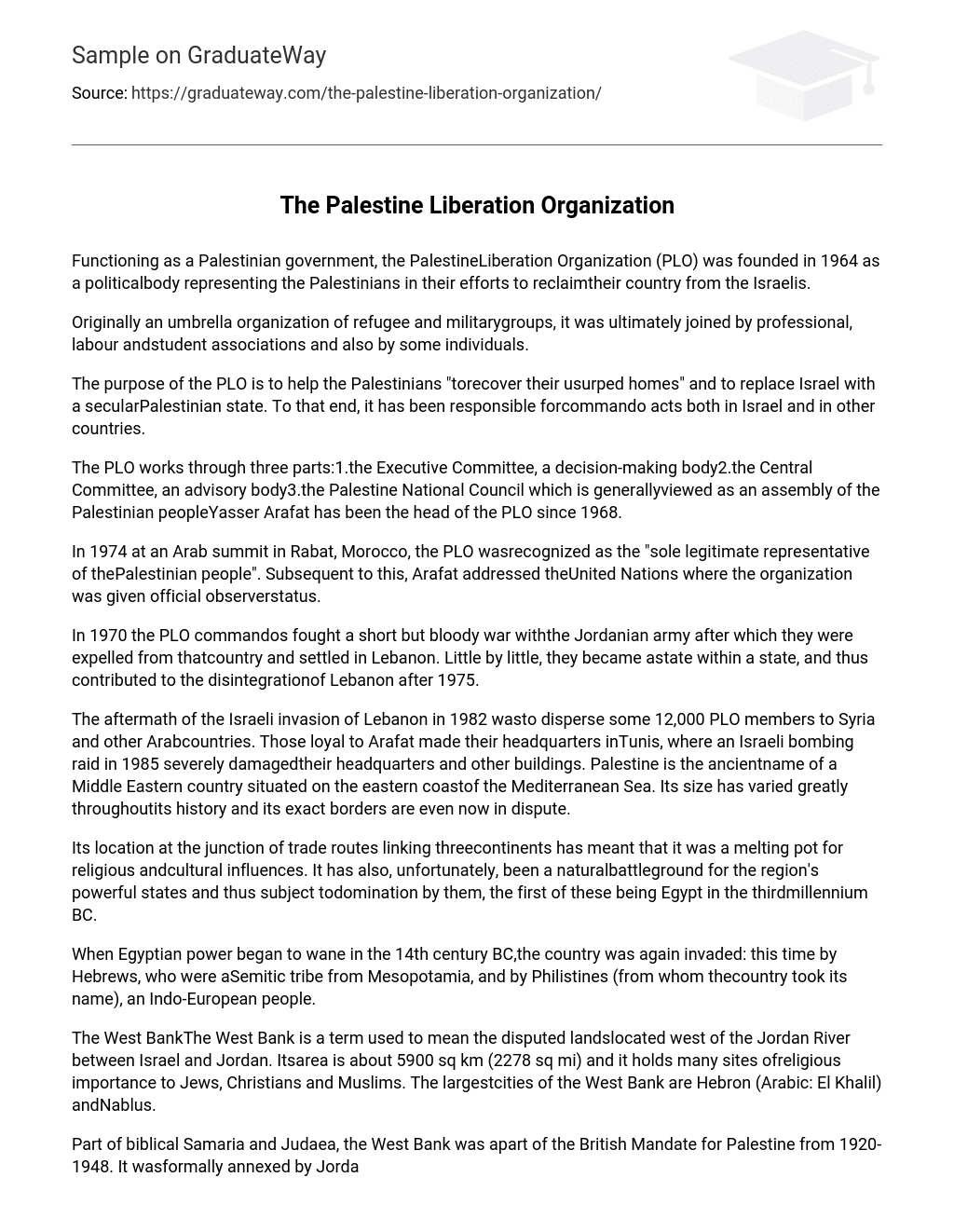Functioning as a Palestinian government, the PalestineLiberation Organization (PLO) was founded in 1964 as a politicalbody representing the Palestinians in their efforts to reclaimtheir country from the Israelis.
Originally an umbrella organization of refugee and militarygroups, it was ultimately joined by professional, labour andstudent associations and also by some individuals.
The purpose of the PLO is to help the Palestinians “torecover their usurped homes” and to replace Israel with a secularPalestinian state. To that end, it has been responsible forcommando acts both in Israel and in other countries.
The PLO works through three parts:1.the Executive Committee, a decision-making body2.the Central Committee, an advisory body3.the Palestine National Council which is generallyviewed as an assembly of the Palestinian peopleYasser Arafat has been the head of the PLO since 1968.
In 1974 at an Arab summit in Rabat, Morocco, the PLO wasrecognized as the “sole legitimate representative of thePalestinian people”. Subsequent to this, Arafat addressed theUnited Nations where the organization was given official observerstatus.
In 1970 the PLO commandos fought a short but bloody war withthe Jordanian army after which they were expelled from thatcountry and settled in Lebanon. Little by little, they became astate within a state, and thus contributed to the disintegrationof Lebanon after 1975.
The aftermath of the Israeli invasion of Lebanon in 1982 wasto disperse some 12,000 PLO members to Syria and other Arabcountries. Those loyal to Arafat made their headquarters inTunis, where an Israeli bombing raid in 1985 severely damagedtheir headquarters and other buildings. Palestine is the ancientname of a Middle Eastern country situated on the eastern coastof the Mediterranean Sea. Its size has varied greatly throughoutits history and its exact borders are even now in dispute.
Its location at the junction of trade routes linking threecontinents has meant that it was a melting pot for religious andcultural influences. It has also, unfortunately, been a naturalbattleground for the region’s powerful states and thus subject todomination by them, the first of these being Egypt in the thirdmillennium BC.
When Egyptian power began to wane in the 14th century BC,the country was again invaded: this time by Hebrews, who were aSemitic tribe from Mesopotamia, and by Philistines (from whom thecountry took its name), an Indo-European people.
The West BankThe West Bank is a term used to mean the disputed landslocated west of the Jordan River between Israel and Jordan. Itsarea is about 5900 sq km (2278 sq mi) and it holds many sites ofreligious importance to Jews, Christians and Muslims. The largestcities of the West Bank are Hebron (Arabic: El Khalil) andNablus.
Part of biblical Samaria and Judaea, the West Bank was apart of the British Mandate for Palestine from 1920-1948. It wasformally annexed by Jordan in 1950 — an act that was notrecognized by the Arab League, the United Nations or the UnitedStates.
After the 1967 Arab-Israeli War, the area came under Israelicontrol.
The Gaza StripThe Gaza Strip is a narrow area of desert land along thewestern Mediterranean Sea. It is about 42km (26 miles) long and6.5 to 8km (4 to 5 miles) wide. It too, like the West Bank, was apart of the British Mandate from 1917 to 1948. Egypt controlledthe Gaza Strip from 1948 until the 1967 Arab-Israeli War (exceptfor a brief period of Israeli occupation in 1956-57) when itpassed to Israeli control.
The Gaza Strip is densely populated — an estimate in 1993gave the figure as 800,000 — with more than 99% of itspopulation being stateless Palestinian Arabs. The majorityare refugees from Israel who have lived under extremely difficultconditions in refugee camps since 1948.
The flimsy economy is based upon agriculture, livestock,fishing and some small industry. Poverty and unemployment arewidespread and the success of the 1993 peace accord between thePalestinians and Israel depends in no small way upon whethereconomic progress for the people of the Gaza Strip is anoutgrowth of the accord.
The intifadaThe intifada is a revolt by Palestinian Arabs againstIsraeli military occupation of lands taken in the 1967 Arab-Israeli War. It began in late 1987 in the Gaza Strip and soonspread to the West Bank and East Jerusalem. It involved throwingstones at Israeli soldiers, strikes and business boycotts.
Neither the Israeli government nor the Palestine LiberationOrganization (PLO) were prepared for the movement.
The cause of the intifada is undoubtedly the frustrationgrowing out of the many diplomatic failures to address thegrievances of the Palestinian Arabs. Israeli response to themovement drew worldwide criticism for its harshness, and theintifada in fact compelled the Israeli government to re-evaluatePalestinian nationalism as well as the depth of Palestiniandiscontent, anger, and utter frustration.
In September 1993, the PLO and Israel signed an agreement onPalestinian autonomy in the Gaza Strip and the West Bank town ofJericho. The last Israeli troops withdrew on 18 May 1994.





